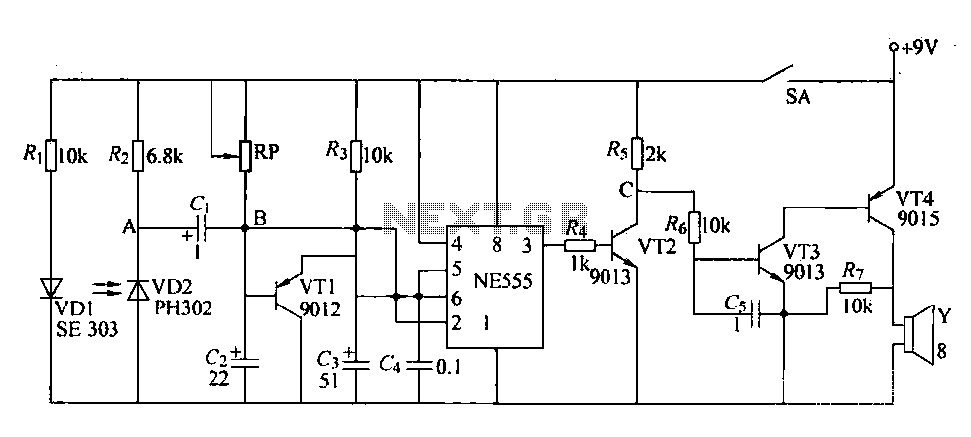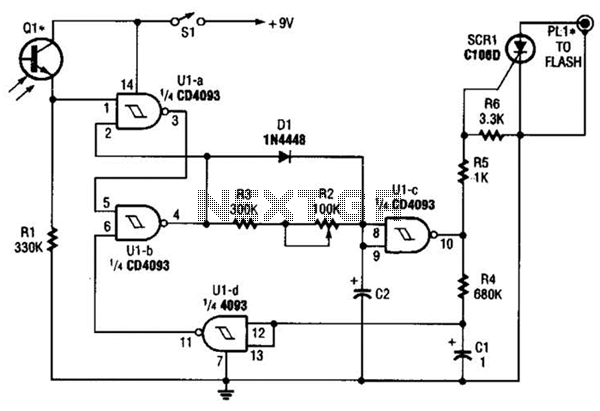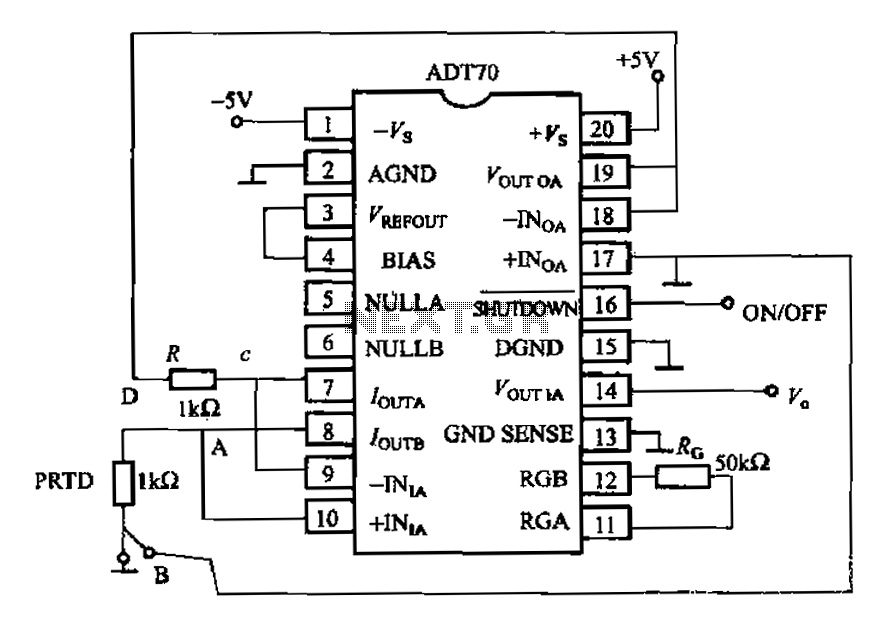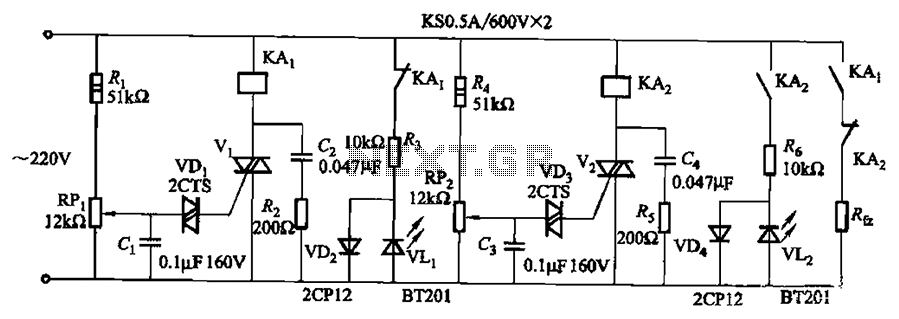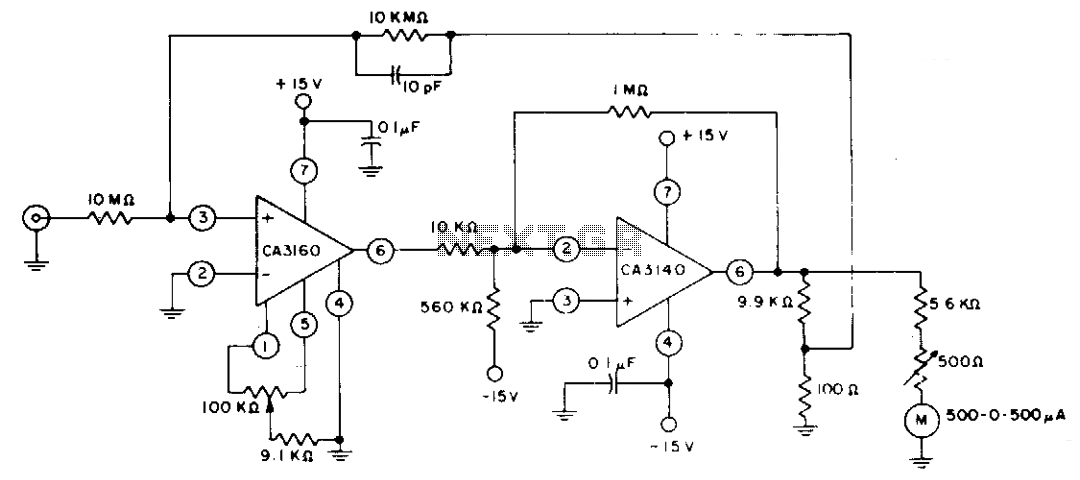
Bi-Color Indicator Circuit
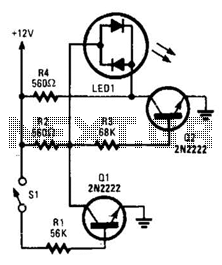
With switch SI open, base bias is supplied to transistor Q2 through a voltage divider formed by resistors R2 and R3, which activates the green element of the LED. This indicates that power is being supplied to the project. When switch SI is closed, current through resistor R1 biases transistor Q1 on, grounding the voltage divider and turning off Q2. This reverses the current flow through the LED, illuminating its red element, which signifies that the circuit is powered and that switch SI, a double-pole double-throw (DPDT) switch, is controlling another circuit.
In this circuit, a bi-color LED serves the dual purpose of indicating when the circuit is powered and the status of switch SI, effectively functioning as two indicators.
The described circuit utilizes a bi-color LED to provide visual feedback regarding the operational status of the circuit and the position of switch SI. The LED consists of two elements: a green LED and a red LED, which are integrated into a single package. The circuit's design leverages the properties of bipolar junction transistors (BJTs) to control the LED's behavior based on the state of switch SI.
When the switch SI is in the open position, the voltage divider formed by resistors R2 and R3 ensures that a sufficient base voltage is applied to transistor Q2. This action turns on Q2, allowing current to flow through the green LED element, thus illuminating it. The illumination of the green LED serves as an indicator that the circuit is powered and operational.
Upon closing switch SI, the current flowing through resistor R1 provides base bias to transistor Q1. This results in Q1 turning on, which effectively grounds the voltage divider consisting of R2 and R3. As a consequence, Q2 is turned off, leading to the cessation of current through the green LED. The change in current flow results in the red LED element being activated, indicating that the circuit is under power and that switch SI is engaged in controlling another circuit.
The bi-color LED's functionality is enhanced by the use of BJTs, which allow for reliable switching and clear visual indications of the circuit's status. This design is particularly useful in applications where it is essential to monitor both power status and the state of control switches, providing a compact and effective solution for circuit indication. With SI open, base bias is supplied to Q2 through a voltage divider (formed by R2 and R3), thus turning on the green element in the LED. That indicates that power is being supplied to the project. If you close SI, current through R1 biases Ql on, thereby grounding the voltage divider and turning off Q2.
That reverses the flow of current through the LED, which causes its red element to light. That indicates that the circuit is under power and SI (really a DPDT switch), whose remaining section controls another circuit, is active. In this circuit, a bi-color LED is used to indicate when a circuit is under power and the status of SI. In that way, the LED does the job of two indicators.
In this circuit, a bi-color LED serves the dual purpose of indicating when the circuit is powered and the status of switch SI, effectively functioning as two indicators.
The described circuit utilizes a bi-color LED to provide visual feedback regarding the operational status of the circuit and the position of switch SI. The LED consists of two elements: a green LED and a red LED, which are integrated into a single package. The circuit's design leverages the properties of bipolar junction transistors (BJTs) to control the LED's behavior based on the state of switch SI.
When the switch SI is in the open position, the voltage divider formed by resistors R2 and R3 ensures that a sufficient base voltage is applied to transistor Q2. This action turns on Q2, allowing current to flow through the green LED element, thus illuminating it. The illumination of the green LED serves as an indicator that the circuit is powered and operational.
Upon closing switch SI, the current flowing through resistor R1 provides base bias to transistor Q1. This results in Q1 turning on, which effectively grounds the voltage divider consisting of R2 and R3. As a consequence, Q2 is turned off, leading to the cessation of current through the green LED. The change in current flow results in the red LED element being activated, indicating that the circuit is under power and that switch SI is engaged in controlling another circuit.
The bi-color LED's functionality is enhanced by the use of BJTs, which allow for reliable switching and clear visual indications of the circuit's status. This design is particularly useful in applications where it is essential to monitor both power status and the state of control switches, providing a compact and effective solution for circuit indication. With SI open, base bias is supplied to Q2 through a voltage divider (formed by R2 and R3), thus turning on the green element in the LED. That indicates that power is being supplied to the project. If you close SI, current through R1 biases Ql on, thereby grounding the voltage divider and turning off Q2.
That reverses the flow of current through the LED, which causes its red element to light. That indicates that the circuit is under power and SI (really a DPDT switch), whose remaining section controls another circuit, is active. In this circuit, a bi-color LED is used to indicate when a circuit is under power and the status of SI. In that way, the LED does the job of two indicators.
